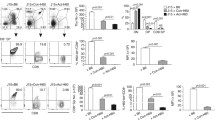Abstract
T cells from radiation chimeras in several strain combinations cause lethal GVHD in irradiated, bone-marrow-protected mice which share the D end of the H-2 complex with the T cells and also have foreign determinants. This phenomenon was not found with T cells from normal mice. I suggest that H-2-restricted GVD cells may be present in normal mice, but their effects may be masked by unrestricted GVH cells, which however, develop more slowly in the chimeras so that lethality due to restricted cells can be observed.
Similar content being viewed by others
References
Billingham, R. E. and Brent, L.: Quantitative studies on tissue transplantation immunity. IV. Induction of tolerance in newborn mice and studies on the phenomenon of runt disease. Philos. Trans. R. Soc. Lond. [Biol.] 242: 439–477, 1959
Corley, R. B. and Kindred, B.: In vivo responses of alloreactive lymphocytes stimulated in vitro. Helpercell activity of MLR-primed lymphocytes. Scand. J. Immunol. 6: 923–932, 1977
Erb, P. and Feldmann, M.: The role of macrophages in the generation of T helper cells. 1. The requirement for macrophages in helper cell induction and characteristics of the macrophage T cell interaction. Cell Immunol. 19: 356–367, 1975
Julius, M. W., Simpson, E., and Herzenberg, L. A.: A rapid method for the isolation of thymus derived murine lymphocytes. Eur. J. Immunol. 3: 645–649, 1973
Katz, D. H., Hamaoka, T., and Benacerraf, B.: Cell interactions between histocompatible T and B lymphocytes. II. Failure of physiologic cooperative interactions between T and B lymphocytes from allogeneic donor strains in humoral response to hapten-protein conjugates. J. Exp. Med. 137: 1405–1418, 1973
Kindred, B. and Shreffler, D. C.: H-2 dependence of cooperation between T and B cells in vivo. J. Immunol. 109: 940–943, 1972
Klein, J., Flaherty, L., VandeBerg, J. L., and Shreffler, D. C.: H-2 haplotypes, genes, regions, and antigens: First listing. Immunogenetics 6: 489–512, 1978
Miller, J. F. A. P., Vadas, M. A., Whitelaw, A., and Gamble, J.: Role of major histocompatibility complex gene products in delayed-type hypersensitivity. Proc. Natl. Acad. Sci. U. S. A. 73: 2486–2490, 1976
Shearer, G. M., Rehn, T. G., and Garbarino, C. A.: Cell-mediated lympholysis of trinitrophenyl-modified autologous lymphocytes. Effector cell specificity to modified cell surface components controlled by the H-2K and H-2D serological regions of the murine major histocompatibility complex. J. Exp. Med. 141: 1348–1364, 1975
van Elven, E. H., Rolink, A. G., van der Veen, F., and Gleichmann, E.: Capacity of genetically different T lymphocytes to induce lethal graft-versus-host disease correlates with their capacity to generate suppression but not with their capacity to generate anti-F1 killer cells. J. Exp. Med. 153: 1474–1981
Zinkernagel, R. M. and Doherty, P. O.: H-2 compatibility requirement for T-cell-mediated lysis of target cells infected with lymphocytec chorio-meningitis virus. J. Exp. Med. 141: 1427–1436, 1975
Author information
Authors and Affiliations
Rights and permissions
About this article
Cite this article
Kindred, B. H-2-restricted lethal graft-versus-host disease. Immunogenetics 14, 527–533 (1981). https://doi.org/10.1007/BF00350124
Received:
Revised:
Issue Date:
DOI: https://doi.org/10.1007/BF00350124




